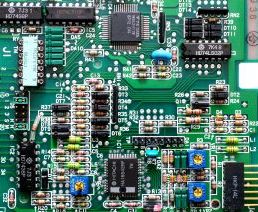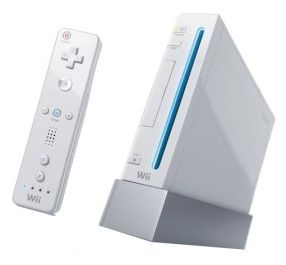The Last Smartphone
or
Apple fans wouldn't recognise a paradigm shift if it bit them on the bottom!
(and neither would fans of Nokia, Motorola, Sony Ericsson, Palm, Blackberry etc.)
Not so smart talk about smartphones
 The recent announcement and unveiling of the iPhone sparked off a lively debate on the internet about what's important in a smartphone, what makes one better than another and what makes one more likely to succeed than another.
The recent announcement and unveiling of the iPhone sparked off a lively debate on the internet about what's important in a smartphone, what makes one better than another and what makes one more likely to succeed than another.Some of the commentary has been neither informative nor entertaining however, and amounts to pure "I'm right you're wrong" abuse rather than reasoned opinion or entertaining invective. Here's an excerpt from a very prominent columnist on a very prominent technology website describing his hatred of iPhone's rivals in an editorial:
"I'm also hoping a crushing wave of shame will overcome anyone who has a Blackberry, or one of its hideous clones from HP, Motorola, Nokia or Palm. Owning one of these is like volunteering for a lobotomy - then boasting about it afterwards."
I assume he was suffering from indigestion when he wrote that...At the other end of the sentimental scale the iPhone launch sparked off a huge amount of what Snopes.com would call glurge: Apple co-founder Steve Wozniak reportedly cried as the iPhone was unveiled, the BBC called it "magical", and Apple itself talked about it as a revolution. Endless armies of Apple fans used that most dreadful and meaningless of dot com era phrases, the "paradigm shift", and preached that this product was something that would completely change the world.
AAS joined in the fun, with (hopefully more level-headed) editorials and coverage of Symbian-related reaction to the unveiling, and this writer also enthusiastically added to the comments sections of various articles.
What a load of couture!
 But then a nagging feeling appeared in me and got stronger and stronger. A feeling that what we were witnessing wasn't a revolution, but an Haute Couture fashion show: a closed-off, echo chamber world where every positive development is a triumph, where your acquaintances all call you darling to your face and bitch behind your back. The hugely expensive products being sold are bought not because they're necessary but because they're fashionable and desirable.
But then a nagging feeling appeared in me and got stronger and stronger. A feeling that what we were witnessing wasn't a revolution, but an Haute Couture fashion show: a closed-off, echo chamber world where every positive development is a triumph, where your acquaintances all call you darling to your face and bitch behind your back. The hugely expensive products being sold are bought not because they're necessary but because they're fashionable and desirable.
It's not that there's anything physically lacking in the current crop of cutting edge smartphones, what feels wrong is the whole direction that the industry is being pushed in, and the encouragement it receives from the media and technology fans to go in this direction.
The talk of a "revolution" sounds especially hollow because it completely misrepresents what a revolution is: something that touches the lives of as many people as possible as profoundly as possible. Technologically cutting edge gadgets like the Apple iPhone or Nokia N95 are going in completely the opposite direction to a revolution, and by concentrating on them their manufacturers are deliberately restricting the breadth and depth of their products' influence.
The smartphone makers are putting down a revolution, not starting one, because the destiny of smartphones to be tools that are genuinely widely used instead of luxury items is a distinctly unprofitable one. When companies concentrate entirely on expensive cutting edge fashionable products whose specifications far exceed what is required of them, they slow the spread of technology instead of speeding it up.
This might sound like goddamn anti-corporate no-good communist talk, but it's quite the opposite: the free market will almost certainly bring about a real smartphone revolution, as it has done with most technological upheavals. When that happens, the well-known smartphone manufacturers and their big name companies and brands will be completely insignificant and interchangeable. Buying smartphones from one company will be pretty much like buying them from any other.
An infamous 2003 article called IT Doesn't Matter first made this kind of claim about business information technology, that as particular technologies become most widely used they also become incredibly cheap and near-identical. In the end the only important difference between them is price. The claim could apply to a very wide range of technologies, including smartphones: the more widely a particular type of product is used, the less any individual manufacturer matters and the less attention you pay to brands or models.
Think of it this way: if you're buying the cheapest phone possible, the brand and model matters far less than if you're buying an expensive smartphone. The cheapest phones all do pretty much the same thing for roughly the same price, no matter who makes them. And it's the cheapest phones that are used most widely and have the biggest effect on the world: a billion mobile phones a year are sold but just 5% of these are smartphones, with an even tinier percentage buying the very latest smartphones.
If a new technology is invented, that's an innovation. When innovative technology brings about large scale change in the world, only at that stage does it become a revolution. In the case of products aimed at individuals, revolutions normally only happen when the innovative technology becomes cheap enough that anyone can afford to buy it.
Real technological revolutions in consumer products happen a million miles from the cutting edge, and products at the cutting edge are a million miles from any revolutions.
Do people want cheaper air travel or more champagne?
Which of the following does more to revolutionise the airline industry: the cheap no-frills airline (no food, no drinks, just travel) or the latest first class cabins with fully flat beds and champagne on tap?

An in-flight meal or a ticket that costs £100 less? Hmm... tricky...
First class cabins earn the airlines more money, make the passengers more comfortable and provide journalists with far more interesting articles and photos, but it's dull low cost airlines (and charter flights before them) that have changed the world of air travel. They've turned the aeroplane from a rare luxury enjoyed by a privileged few into a service cheap enough to be used by almost anyone who wants to, at least in the rich world. They've done it by stripping away as much unnecessary cost as possible even if it means making the flights less pleasant, because they know that most people would rather keep the money and go without the in-flight chicken kiev.
This feels counter-intuitive though. Cheap airlines feel like the opposite of progress: they're dingy and unsexy, they're uninteresting in themselves, and in terms of the actual flying experience they're clearly the bottom of the barrel. But by golly cheap flights are popular, and their popularity derives from their revolutionary low prices. This is something genuinely new and important: it's turning the travel itself into the entire product and making the experience in the air completely irrelevant, rather than maintaining the old-fashioned but profitable fantasy of it being a luxury service.
In this context, which of the following would do more to revolutionise the smartphone industry: a smartphone which costs over $500, or a smartphone which costs less than $100?
Technology fans don't really want a revolution
 The iPhone will cost $599 (by some reports the true standalone cost may be much higher), and will require users to sign a two year contract with the Cingular phone network and pay regular monthly fees for the entire 2 years. Other smartphone manufacturers' cutting edge models have similarly hefty price tags and conditions.
The iPhone will cost $599 (by some reports the true standalone cost may be much higher), and will require users to sign a two year contract with the Cingular phone network and pay regular monthly fees for the entire 2 years. Other smartphone manufacturers' cutting edge models have similarly hefty price tags and conditions.
These smartphones are not the equivalent of low cost airlines, these aren't mass market products the way cheap phones are, and even in rich countries the majority of people will never buy a smartphone even if they can theoretically afford one. They're the equivalent of the flat beds in first class cabins, a great step forward in luxury but completely irrelevant to most people. As far as the majority are concerned, these smartphones might as well not exist because they make no difference to their lives.
"But wait", I hear tech fans say, "these are devices which provide the world with important new technologies!"
Well, first of all the technologies aren't strictly speaking new. They may be new to phones or portable devices, but they've usually had an outing somewhere else beforehand.
None of these devices has introduced any completely new technology, not even the iPhone. Finger touchscreens have been around for years, for example Nokia unveiled a finger touchscreen device last Monday called the N800 (you can see it in the picture), and Philips had a multiple-press touchscreen gaming device at last year's E3 expo in May 2006. Smartphones are mostly portable bundles of existing technology, often quite long established technology (how many people reading this remember visiting museums in their childhood that featured finger touchscreen displays?).
But even if you disagree, and we assume there are lots of brand new major technologies invented specially for the latest smartphones, while that's interesting and innovative it won't have a wide impact simply by existing. The vast majority of people simply can't afford these models so it almost certainly won't affect their lives at all.
At best these new smartphones are low-selling demonstrations of concepts, which only a few lucky folks have enough money to buy, just like the Haute Couture mentioned at the start of this article.
By the time these technologies are cheap enough to spread round the globe and start a real revolution, most tech fans will have completely forgotten about them and will treat them as obsolete, despite the fact that their new low price means they're just becoming truly useful.
It seems that most technology enthusiasts don't really care about making a difference to the world at large, despite all their talk of revolutions and paradigm shifts. Most seem to think the purpose of gadgets is to be as cool as possible by featuring the latest and best hardware, rather than tackling real world problems with affordable and efficient solutions.
The Technology media don't really want a revolution
 Everyone agrees that at its heart technology is supposed to be a useful tool, but for many it's used mainly as a very expensive toy and status symbol.
Everyone agrees that at its heart technology is supposed to be a useful tool, but for many it's used mainly as a very expensive toy and status symbol.
Most hi-tech companies, web sites and gadget fans now have a distorted approach to what it means for a technology to be better or more successful. The situation in the technology media is particularly bad:
- Almost all the people who write about technology are high technology enthusiasts, the newer and snazzier the gadgets the happier they are. They tend to see a lack of features as a handicap, and very rarely complain about a device having too many features. This is the equivalent of a news service using military hardware enthusiasts as their war correspondents: it would mean a tendency to cover conflicts in terms of the weapons used rather than the factors that start and stop wars.
- Technology journalists get most or all of their gadgets for free (Ed's note: err.... we do usually have to give them back though!), so the device's features will have a far greater direct effect on them than the device's retail price. Most of them have to add price considerations to their reviews in an artificial manner which doesn't involve direct experience.
- Most technology coverage is paid for by advertisers who prefer their audience to be homogeneous (so that every single advert works on as much of the audience as possible), wealthy and have plenty of disposable income. It makes commercial sense for web sites and magazines to aim their coverage at this demographic, so they do.
- Most of the direct feedback technology manufacturers get is from the technology media, so there's a tendency to see that feedback as representative of the world at large.
Combine these problems together and you end up with a worrying trend: technology bloat is rewarded and value-for-money is ignored. Things like price drops are fairly minor events, yet a major price drop can be revolutionary and often makes the difference between a niche product and a widely used technology.
It was a series of massive year-on-year price drops, not any extra features, that made the mobile phone spread not just across the rich world but all around the globe, yet these hugely significant cheap models received much less coverage in the technology media than the latest developments at the cutting edge.
Technology companies don't really want a revolution
 Measuring the success of a technology ought to be based around how widely that technology is adopted, yet the consistently high price tags on most new products stop technology from being more widely used. Why does this keep happening time after time, even when the development costs of a new technology have been paid off?
Measuring the success of a technology ought to be based around how widely that technology is adopted, yet the consistently high price tags on most new products stop technology from being more widely used. Why does this keep happening time after time, even when the development costs of a new technology have been paid off?
For a couple of years now DVD players have hit rock bottom prices: a player can be bought for about $25 which is easily good enough for most people's needs. Sales of DVD hardware and discs are enormous, almost all developed world consumers can afford to buy them, and everyone's happy. The DVD revolution really has happened, at least in the rich world. It's a truly successful technology.
But at $25 a pop there's barely any profit to be made in making a DVD player, and although there are still expensive high end models their prices are also dropping and ever-fewer people buy them any more. All DVD players do pretty much the same thing well enough for most people, so the brands have become more invisible and the only important difference left between them is the price. It's great news for consumers, great news for the technology itself, but terrible news for the manufacturers and their shareholders, who earn a fraction of what they used to. DVD player manufacturers nowadays have to do far more work to earn far less money, and there's none of the glamour or fame that they used to have. Even worse, because the technology has spread to almost everyone who wants it, there's almost no growth any more.
In short, technology companies hate revolutions, they hate a technology becoming all-pervasive and cheap enough for anyone to buy because it wipes out the two things that increase their value as a company: profitability and growth. If they don't have these two things, their share price will drop and they can be taken over by a rival, making them disappear completely.
That's why, mysteriously, just as televisions and DVD players have fulfilled all the consumer's requirements of an ideal product, the industry suddenly wants consumers to throw them away and replace them with next generation Blu-Ray & HD DVD players and High Definition TV sets, which of course cost ten or twenty times more than the things they replace. It's the only way the companies can survive.
A Revolution: How to recognise its arrival
 This process of constant renewal is in many ways a very good thing: in replacing standard televisions and DVD, the industry gives us radically better televisions and video disc players, and technology moves forward.
This process of constant renewal is in many ways a very good thing: in replacing standard televisions and DVD, the industry gives us radically better televisions and video disc players, and technology moves forward.
But it can't go on forever, there are natural limits to how much we physically need certain technologies, and at some point there simply won't be a market for expensive upgrades. One of those limits is the Compact Disc.
The CD was an absolute godsend to the music industry, it meant an increasingly large number of people wanted to replace their hi-fis and entire record collections with expensive new players and CDs, and loads of money started pouring into various companies' bank accounts. But eventually when CD had completely displaced vinyl, CD player prices nosedived to the same cheap level as the vinyl record players they replaced, and the industry was right back where it started.
So some of the music industry tried to kick start the whole replacement process with various new formats such as DVD Audio. None of them worked, most people couldn't see or hear any real benefit in any of the new standards over CD albums, and compact disc players and recorders continued to get better and cheaper. The CD revolution had arrived. In a curious kind of way, CD technology took on a life of its own, and while it wasn't perfect it was good enough to survive any attempt to replace it. CD became a permanent fixture in most people's lives, but it was no longer a cash cow for hardware manufacturers.
It seems that the Compact Disc will be the last physical audio format, it's as good as people need it to be and as cheap as manufacturers can make it.
Most products have tended to go through the same process: they start off all sexy with a great fuss made about them, famous brands, expensive products, fan clubs, magazines, fairground rides, etc. Their success attracts money and the technology gets more and more developed, and it seems the party will never end. But then one day it's so developed that there's no call for any improvement. The only thing left to do in order to keep sales growing is to drop the price, but then the price also hits a dead end beyond which it can't be dropped. And then there's nothing left at all. No excitement, no magazine columnists getting all hot under the collar because of some technical detail or another, no enormous launch parties.
There's nothing but the technology itself, and all the useful stuff that can be done with it.
And that's when the technology's revolution happens.
The technology spreads as far as it's possible for it to spread because it's as cheap and as refined as possible. People often can't live without it, but no one really notices it or pays it much attention because it's about as exciting as a tin opener.
Smartphones are the new Tinned Food
 Before you scoff at a comparison between a tin opener and cutting edge technology, you ought to remember that tinned food was once cutting edge technology too. A tin is still the cheapest and most durable way of storing fresh food at room temperature for many months, vital if you want to travel long distances through areas where there's no reliable food supplies. For over 100 years many military campaigns have depended on a supply of tinned food, and that's just one example of tins changing history. We use tins today all over the world because there's no way of improving on its price and utility. Tins have had a far greater impact on the world than smartphones have, and they continue to have a greater impact.
Before you scoff at a comparison between a tin opener and cutting edge technology, you ought to remember that tinned food was once cutting edge technology too. A tin is still the cheapest and most durable way of storing fresh food at room temperature for many months, vital if you want to travel long distances through areas where there's no reliable food supplies. For over 100 years many military campaigns have depended on a supply of tinned food, and that's just one example of tins changing history. We use tins today all over the world because there's no way of improving on its price and utility. Tins have had a far greater impact on the world than smartphones have, and they continue to have a greater impact.
And the strange thing is, although we depend far more on tinned food than on smartphones, you don't see Tin World magazine at your local newsagent or huge Tin Expo conventions celebrating the latest in tinned food technology. However, here's how Wikipedia describes the initial excitement that surrounded tinned food in the period after its invention:
"Initially, the canning process was slow and labour-intensive, as each can had to be hand-made and took up to six hours to cook properly, making tinned food too expensive for ordinary people to buy. Throughout the mid-nineteenth century, tinned food became a status symbol amongst middle-class households in Europe, becoming something of a frivolous novelty."
Too expensive for ordinary people to buy? Status symbol? Frivolous novelty?
All of those phrases could be applied to smartphones right now, and that's exactly why smartphones aren't revolutionary yet. They need to lose all of those properties before they can intertwine with our lives unnoticeably, the way tins and tin openers have done. The latest smartphones are all prohibitively expensive for most people, they're all marketed as status symbols, and most of what they do is frivolous novelty. That all has to go.
Once a technology does change the world and becomes indispensable, it will only be noticed when it's missing, like the floor.
The Last Smartphone
 So, what would the last smartphone be like? What will the final model do, when they've become indistinguishable from each other and as common as tinned food?
So, what would the last smartphone be like? What will the final model do, when they've become indistinguishable from each other and as common as tinned food?
Here's one possible vision of the day smartphones stop growing up:
- All your files and applications would be stored and accessed online, the smartphone's only major task would be to run the internet application/browser so you can access those files and apps when you're on the move. The online apps would include all communication and media functions, as well as navigation, payment, timekeeping etc.
- The internet connection would be fast and reliable enough to stream all your media files, and the connection's latency would be small enough not to be noticeable to the average person.
- There would be cameras in the phone which would have such high resolutions and frame rates that the human eye wouldn't be able to distinguish between them and upgraded models, so upgrades would be pointless.
- The display would also be such high quality that any further upgrades would be undetectable to the untrained eye.
- If you wanted to use buttons you could snap them onto the phone, if you just want to touch the display directly you could leave off the buttons.
- The device would be a cheap and everyday item that anyone could afford, to the extent that it wouldn't matter if you broke it. You could buy a new one from any supermarket or electrical shop as soon as you need one, or you could keep a box of spare phones at home in the same way people nowadays keep a spare box of fuses and lightbulbs.
All your software would be run on remote servers whose technology is completely invisible to you, just as the web server from which you're reading this article is invisible to you. Although these servers and their software would be maintained, upgraded and developed over time, you wouldn't pay attention to this any more than you'd pay attention to upgrades at your local power station or sewage treatment plant.
There might be some expensive variation between models for the sake of fashion, but this would be money for the cosmetic exterior. The smartphone inside would be an insignificant cost, like the electronics of a digital watch today.
In essence, there would be nowhere left to go with developing the smartphone's technology any further, and the price would have hit rock bottom too. It would be a window onto the internet without any particular distinguishing features or drawbacks, a means to an end instead of an end in itself.
The End
EPILOGUE:
Real Revolutions
Actually Making A Difference
So if just having cutting edge technology doesn't count, what is a real revolution in technology? When can a product be called truly revolutionary?The problem is that because a revolutionary product tends to be cheap enough for everyone to afford it, it will tend not to feature any sexy new technology. This doesn't make for good copy on tech web sites that are happier with listing features than discussing economics, nor will it attract the attention of bloggers or the media in general, but it will change things.
One thing that ought to distinguish a revolutionary gadget is whether it allows something new and important to happen that wasn't possible before. This is a completely arbitrary list and in no particular order, meant as a list of random examples rather than a "Top 7":
1. Really Cheap Mobile Phones
 To their credit, for the last couple of years Motorola, Nokia and other handset makers have put resources into creating and promoting very low price and reliable mobile phones aimed at the developing world. Although the manufacturers' true motives are probably more to do with getting in early in areas with high growth potential, they are nonetheless helping the poor in ways that no one really expected. A brand new unsubsidised handset from a major manufacturer can now be had for under $50, which is still a lot in most of the world but not an unattainable sum. It's an especially plausible purchase if the owner can use it to generate extra income and make it pay for itself. The BBC has carried several reports on this phenomenon over the years, particularly in Tanzania where a taxi driver doubled his income from $7 a day to $15 after buying a mobile, and fisherman carry phones in their boats off the coast to check which port has the best prices before heading in to land.
To their credit, for the last couple of years Motorola, Nokia and other handset makers have put resources into creating and promoting very low price and reliable mobile phones aimed at the developing world. Although the manufacturers' true motives are probably more to do with getting in early in areas with high growth potential, they are nonetheless helping the poor in ways that no one really expected. A brand new unsubsidised handset from a major manufacturer can now be had for under $50, which is still a lot in most of the world but not an unattainable sum. It's an especially plausible purchase if the owner can use it to generate extra income and make it pay for itself. The BBC has carried several reports on this phenomenon over the years, particularly in Tanzania where a taxi driver doubled his income from $7 a day to $15 after buying a mobile, and fisherman carry phones in their boats off the coast to check which port has the best prices before heading in to land.
It's also far cheaper and quicker to set up mobile phone networks than landline ones, which means the high costs and slow progress of building a physical phone networks can be leapfrogged by just skipping that stage of development. The most extreme example of just how easy it is to do this happened in war torn Iraq just months after the toppling of Saddam in 2003, where it seems parties unknown managed to set up a completely unauthorised GSM network without anyone knowing about it until it was up and running .
2. The Clockwork Radio
 The clockwork radio was invented by Trevor Baylis, and it made him probably the most famous living British inventor. Made in co-operation with the South African company Baygen, it's a standard FM/AM radio powered by rechargeable batteries, but the batteries are recharged by turning a lever on the front of the radio. It sounds like a trivial feature, indeed using clockwork technology from the 19th Century sounds like a huge step backwards, but it's actually incredibly clever and makes it more useful than any other communication device in extreme situations: it's the only practical way of keeping a large population in touch with what's happening when that population has no access to electricity, batteries or phone lines.
The clockwork radio was invented by Trevor Baylis, and it made him probably the most famous living British inventor. Made in co-operation with the South African company Baygen, it's a standard FM/AM radio powered by rechargeable batteries, but the batteries are recharged by turning a lever on the front of the radio. It sounds like a trivial feature, indeed using clockwork technology from the 19th Century sounds like a huge step backwards, but it's actually incredibly clever and makes it more useful than any other communication device in extreme situations: it's the only practical way of keeping a large population in touch with what's happening when that population has no access to electricity, batteries or phone lines.
It's clearly useful in the developing world, especially in areas with low population densities and isolated communities, but it's also handy for disasters in the rich world where all the usual infrastructure has been destroyed and the only thing working is a radio. It's also an interesting vindication of starting from the low end of technology instead of the high end and only using what you absolutely need in the device: the clockwork radio is very cheap (which is great for developing countries) and very durable (so it's far more likely to survive a disaster).
3. The Nintendo Wii
 No, I'm not choosing this games console from 2006 because of its unusual motion-based controller. I'm choosing it because for the first time in video game history the hardware isn't substantially upgraded from the previous generation, it's merely a slightly souped up version of the Wii's predecessor the GameCube. If it outsells its rivals in the coming years, the technologically far superior Xbox 360 and Sony PlayStation 3, it will prove that expensive new technology isn't necessarily something that consumers want in a new console.
No, I'm not choosing this games console from 2006 because of its unusual motion-based controller. I'm choosing it because for the first time in video game history the hardware isn't substantially upgraded from the previous generation, it's merely a slightly souped up version of the Wii's predecessor the GameCube. If it outsells its rivals in the coming years, the technologically far superior Xbox 360 and Sony PlayStation 3, it will prove that expensive new technology isn't necessarily something that consumers want in a new console.
Stricly speaking the Wii isn't revolutionary... yet. But it's heading in the right direction in a way that no other console has ever tried to, and for that it deserves to be on this list.
This strategy could bring both the price of consoles and the development costs of games down, which is vital if gaming is to have any chance of being as widespread as video or music or books. At the moment a typical video, CD or paperback cost approximately one quarter of the price of a new video game. A typical DVD or CD player costs one tenth the price of a new games console. On average a console owner only buys 4 to 8 games over a 5 year period, far less than they'd buy films or albums or books.
If those gaps can be narrowed by reducing hardware and development costs, the games console would move from being an expensive luxury to being an everyday part of life.
4. Amstrad PC1512
 Almost completely forgotten now in a world where cheap home PCs are taken for granted, the PC1512 was one of, if not the, first cheap European PCs. It was released for hundreds of dollars in 1986, an age when PCs normally cost thousands of dollars and most users at the time thought the machine would never make it outside of the office. Thanks to the 1512, huge swathes of Europe were suddenly able to buy a PC-compatible, and Amstrad (who had never made PCs before) found themselves responsible for 1 in 4 European PC sales almost overnight. It proved beyond doubt that there was a huge market for cheap consumer-oriented PCs in Europe, and loads of other PC manufacturers agreed. The rest is history.
Almost completely forgotten now in a world where cheap home PCs are taken for granted, the PC1512 was one of, if not the, first cheap European PCs. It was released for hundreds of dollars in 1986, an age when PCs normally cost thousands of dollars and most users at the time thought the machine would never make it outside of the office. Thanks to the 1512, huge swathes of Europe were suddenly able to buy a PC-compatible, and Amstrad (who had never made PCs before) found themselves responsible for 1 in 4 European PC sales almost overnight. It proved beyond doubt that there was a huge market for cheap consumer-oriented PCs in Europe, and loads of other PC manufacturers agreed. The rest is history.
5. Demon Internet
![]() Although the internet had existed in some form since experiments in the 1960s, it was always conceived as a way for research and educational establishments to communicate with each other. It was not thought to have any appeal to the consumer, and pricing for internet access meant that as late as the early 1990s it was practically impossible for an ordinary person in Britain to access the net from their home, despite all the required modem technology being available.
Although the internet had existed in some form since experiments in the 1960s, it was always conceived as a way for research and educational establishments to communicate with each other. It was not thought to have any appeal to the consumer, and pricing for internet access meant that as late as the early 1990s it was practically impossible for an ordinary person in Britain to access the net from their home, despite all the required modem technology being available.
Then in 1992 a small company called Demon Internet started up in the UK and offered individuals the chance to go on the internet from home for a relatively small fee. For the first time in British history, ordinary people were able to pay affordable subscriptions in return for internet access. The huge success of Demon showed there was an enormous untapped market for cheap internet access, and soon many other consumer-oriented ISPs sprang up. It's important to note that there was no technological change behind this revolution, it was entirely down to making it easier for consumers to pay for an existing service accessed with their existing hardware.
6. The $100 Laptop
 Slightly controversial this one, it's a Linux-based laptop that will be manufactured and sold for about $100 to $150 (£50 to £75). The first test batch was made last year, with full production supposed to start later this year. In theory it's meant to be distributed to children in the poorest parts of the world, although this has caused a backlash for various reasons, primarily because some people feel the money could be better spent on other things and also because there will be running costs associated with it (such as internet access) that aren't covered by the initial price.
Slightly controversial this one, it's a Linux-based laptop that will be manufactured and sold for about $100 to $150 (£50 to £75). The first test batch was made last year, with full production supposed to start later this year. In theory it's meant to be distributed to children in the poorest parts of the world, although this has caused a backlash for various reasons, primarily because some people feel the money could be better spent on other things and also because there will be running costs associated with it (such as internet access) that aren't covered by the initial price.
However, the reason I've picked it as a revolutionary device isn't because of the mission to educate the poor, but purely because of the price: if they can manufacture a laptop that can do all the basic functions of a PC for under $150 then it shows just how badly people are being ripped off by current laptop and desktop prices. Yes, this isn't a cutting edge PC but if you just want to do the basics it doesn't have to be, as anyone who's used a PC for more than five years will know.
What's interesting is the reaction it's provoked from people intimately involved with the existing PC industry. Bill Gates seemed particularly scathing, saying that this wasn't a "decent computer". He's wrong of course, a 500 MHz PC with 128MB of RAM and a SVGA monitor is a perfectly decent computer, in fact that's far in excess of what most versions of Windows and MS-DOS were written for. Presumably in 10 years time he'll consider a PC from 2007 to not be a "decent computer" either, and lambast Windows Vista as a primitive useless operating system.
The $100 Laptop is a charity-driven scheme and will probably never be widely distributed in the rich world as its aim is based entirely around the developing world (although some suggestions of limited sales through eBay have recently appeared). But even if we don't see this machine in the developed world, PC costs continue to decline and one day a $100 PC will be available to anyone who wants it, so this machine is perhaps more a taste of the future than a revolution in itself. When PCs cost $100 we'll cease to give a monkeys who manufactures them, and the home computing revolution will have arrived.
7. The $50 Smartphone

